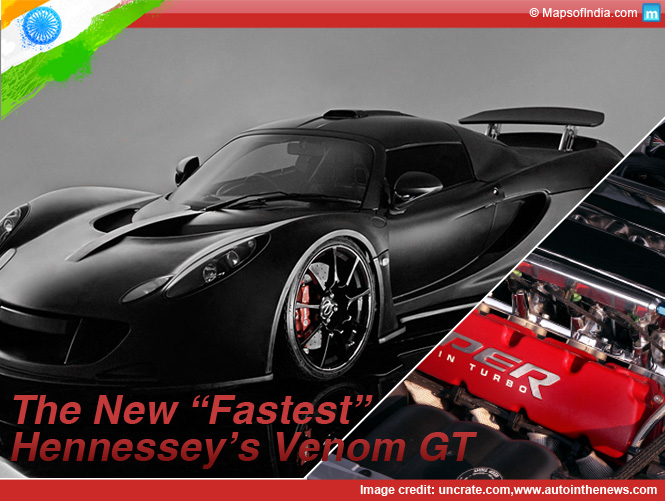If you think you know your cars well and believe that nothing comes close to comparing in speed and power to the Bugatti Veyron Supersport or the Koeniggsegg Agera R or the Pagani Huayra, the Lamborghinis and the Ferraris, think again.
From Texas-based Hennessey Performance Engineering, comes a hypercar that will eat scrambled koenigseggs for breakfast, toss Bugattis and Paganis into a salad for lunch, and level the rest by tea-time.
Powered by a twin turbo 7.0 litre GM LSX V8 with an iron block and aluminium heads featuring twin precision ball bearing turbochargers, the Venom GT – as the hyper is called – is claimed to achieve a top speed of 278 mph (over 447 kmph!), decimating anything even close to a hint of being competition.
In January last year, the Hennessey Venom GT set a Guinness world record for the fastest production car from 0-300 kmph with an average acceleration time of just 13.63 seconds. The car also set an unofficial record for 0-200 miles per hour acceleration at 14.51 seconds, beating the Koenigsegg Agera R’s timing of 14.53 seconds, making it the fastest accelerating car in the world.
Built on a heavily modified Lotus Exige chassis, the Venom GT also borrows components like the roof, doors, side glass, windscreen, dashboard, cockpit, floorpan, HVAC system, headlamps etc from the Lotus. The lightweight carbon fibre body and wheels, allow the GT to have a production curb weight of 1,244 kgs. The brakes on the GT employ Brembo six piston calipers in the front and four piston ones in the back.
The V8 produces an un-bloody-believable 1,244 bhp at 6600 rpm, and this engine output is adjustable by three settings in all – 800 bhp, 1,000 bhp, and 1,200 bhp. The engine power is sent to the rear set of wheels via Ricardo 6 speed manual transmission. Hennessey claims that the power band could also have been stretched upto 2,000 bhp and the car would’ve still pulled through.
Traction control is programmable and manages the power output well. Body work and downforce tested by Computational fluid dynamics, help keep the Venom GT stable. An active aero system with adjustable rear wing deploys under varying conditions on both road and racetrack. The adjustable suspension system allows for ride height to be adjusted by 2.4 inches according to speed and driving conditions. Michelin PS2 tyres help transmit the power to the road.
The engines are manufactured at Hennessey’s facility in Sealy, Texas, and then air freighted to the company’s assembly facility near Silverstone, England where the GT is built and then tested. Buyers are offered a one-day driver orientation and instruction program by a Hennessey factory test driver at a track in the UK or USA before delivery of the car.
There are plans of establishing a network of Venom GT dealer and distributorships in the Middle East, Europe, Russia, Australia and Asia. Production will be kept at 10 vehicles per year. The 800 bhp version is priced at US$ 600000, AND THE 1200 bhp version comes for US$ 1.25 mil. As of February this year, 11 Venom GTs have rolled off the assembly line. Hennessey had made it clear from the beginning that they would only be building 29 of these mad machines.
On 3rd April 2013, the Venom GT achieved 428 kmph over the 2 mile course of United States Naval Air Station in Lemoore, California. February this year, on the Kennedy Space Centre’s 3.22 mile landing strip in Florida, the GT did 435.3 kmph, driven by Brian Smith, Director, Miller Motorsport.
The test run was carried out in one direction only and Hennessey say that NASA didn’t allow them a second run in the opposite direction since getting the permission was a long two-year process to begin with. Since the car ran only in one direction and the company as to date, produced just 11 units, the Venom GT does not officially qualify as Guinness’ fastest production car, as it would require a two-way run and a minimum production number of 30 units.
Hennessey believe that with a longer run the car could just as easily touch 280 mph. They do not see the GT as a Veyron competitior since they aim at making not just the fastest, but also the lightest cars, and Veyrons, like Bentleys (in Hennessey’s words) are comfortable cars.
Although there aren’t any immediate v-max runs in the pipeline, Hennessey plans on tweaking around with the gearing and attacking some of the well-known race circuits around the world, in order to validate some serious performance numbers. They also look forward to doing the Top Gear test track and hope that with the Stig at the wheel, their car could easily score the top of the list and achieve a number close to 1 minute and 12 or 13 seconds. With the craziest test driver in the world, achieving that, would be a bigger validation than breaking the 270 miles per hour mark.





